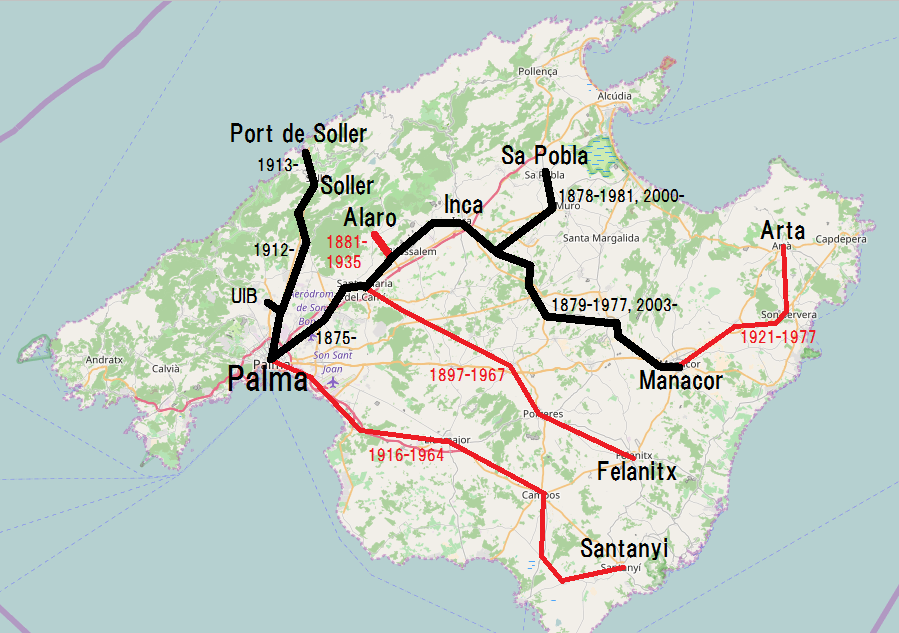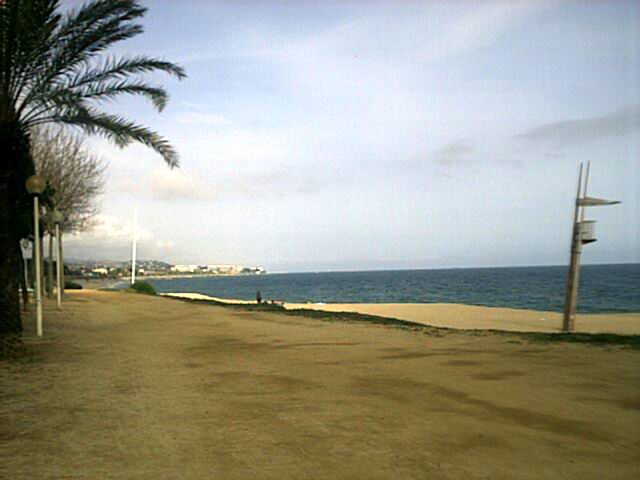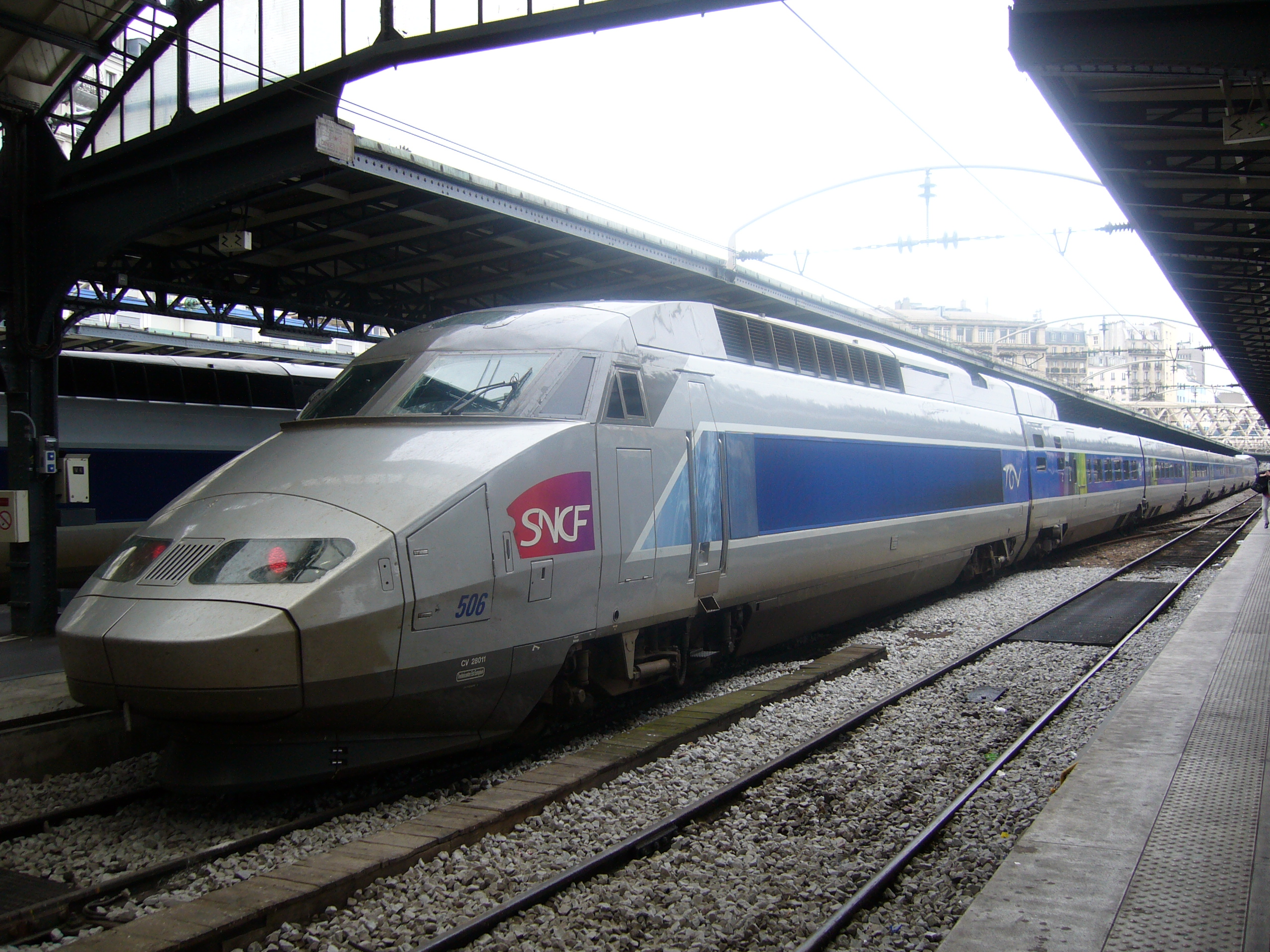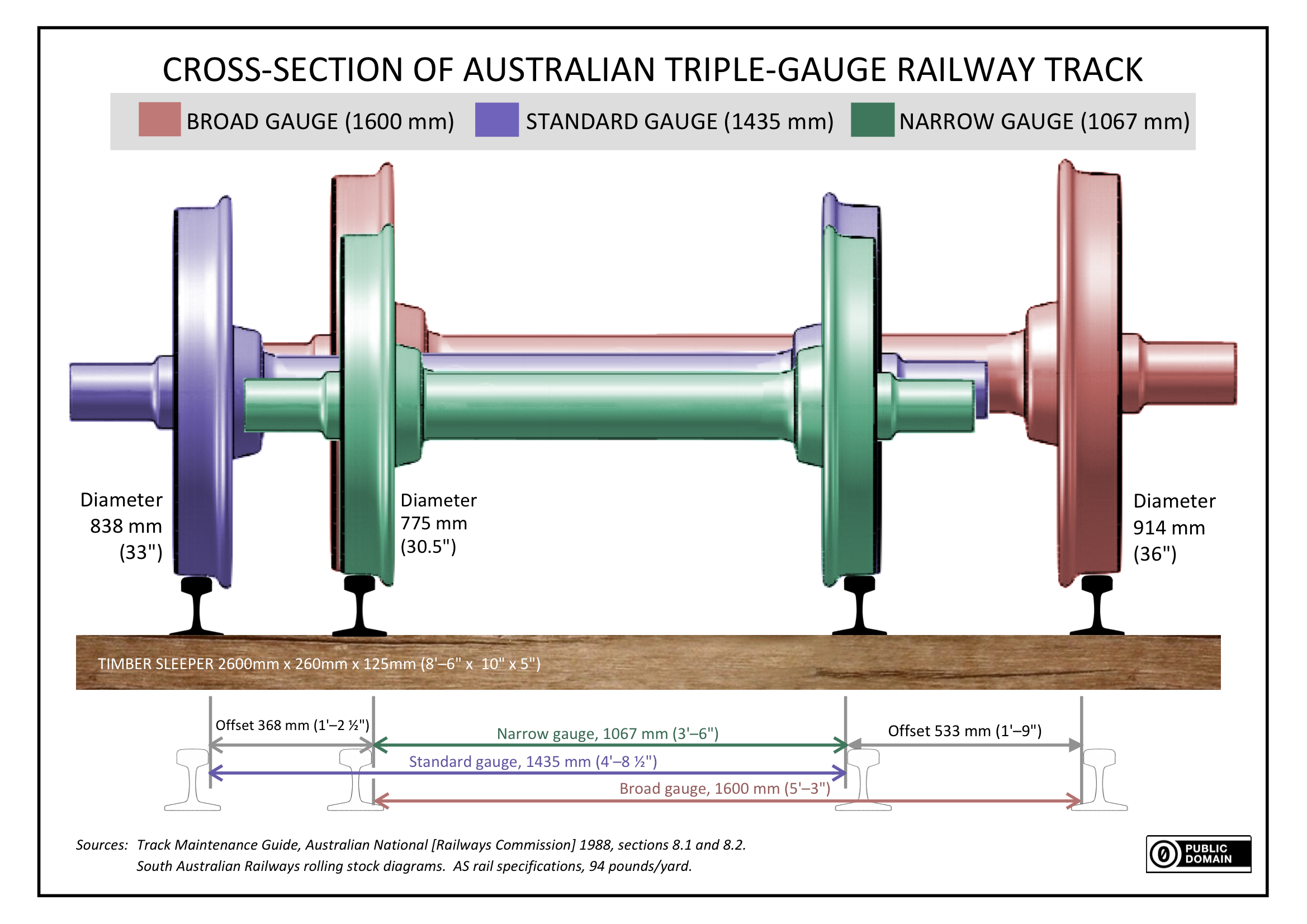|
Rail Transport In Spain
Rail transport in Spain operates on four rail gauges and services are operated by a variety of private and public operators. Total railway length in 2020 was 15,489 km (9,953 km electrified). The Spanish high-speed rail network is the longest HSR network in Europe with 3,973 km (2,464 mi) and the second longest in the world, after China's. Most trains are operated by Renfe; metre and narrow-gauge trains are operated by the Renfe Cercanías AM division. Local publicly-owned operators include Euskotren in the Basque Country, FGC in Catalonia and Serveis Ferroviaris de Mallorca in the Balearic Islands. High speed train operators other than Renfe include Ouigo and Iryo. It is proposed and planned to build or convert more lines to standard gauge, including some dual gauging of broad-gauge lines, especially where these lines link to France, including platforms to be raised. Spain is a member of the International Union of Railways (UIC). The UIC Country Code for Spain i ... [...More Info...] [...Related Items...] OR: [Wikipedia] [Google] [Baidu] |
Serveis Ferroviaris De Mallorca
Serveis Ferroviaris de Mallorca () or SFM is a company which operates the metre gauge railway network on the Spanish island of Majorca. The total length, including Palma Metro, also operated by this company, is . Overview In 1977, the line Palma – Inca was the sole remnant of a network that once connected Palma with most of the island. In 2001, the section Inca – Sa Pobla reopened, followed by the section Inca – Sineu in 2002 and Sineu – Manacor in 2003. The expected extension of the branch line from Sa Pobla onwards to Alcúdia in 2005 has yet to be built. The line from Manacor to Artà was under construction for a planned 2012 reopening. The project was halted in 2013 (with most of the groundwork completed) and an announcement made that the route instead was to be converted "for the time being") to a '' via verde'' for cyclists and walkers. Electrification €30m was invested in electrifying the whole line, from Palma to Inca, at 1.5 kV DC, which was completed ... [...More Info...] [...Related Items...] OR: [Wikipedia] [Google] [Baidu] |
Madrid
Madrid ( ; ) is the capital and List of largest cities in Spain, most populous municipality of Spain. It has almost 3.5 million inhabitants and a Madrid metropolitan area, metropolitan area population of approximately 7 million. It is the Largest cities of the European Union by population within city limits, second-largest city in the European Union (EU), and its wikt:monocentric, monocentric Madrid metropolitan area, metropolitan area is the List of metropolitan areas in Europe by population, second-largest in the EU.United Nations Department of Economic and Social AffairWorld Urbanization Prospects (2007 revision), (United Nations, 2008), Table A.12. Data for 2007. The municipality covers geographical area. Madrid lies on the Manzanares (river), River Manzanares in the central part of the Iberian Peninsula at about above mean sea level. The capital city of both Spain and the surrounding Community of Madrid, autonomous community of Madrid (since 1983), it is also th ... [...More Info...] [...Related Items...] OR: [Wikipedia] [Google] [Baidu] |
Mataró
Mataró () is the capital and largest town of the Maresme county in Catalonia, Spain. It is located on the Costa del Maresme, Maresme coast, to the south of Costa Brava, between Cabrera de Mar and Sant Andreu de Llavaneres, north-east of Barcelona. , it had a population of 129,749. History Mataró dates back to Roman Republic, Roman times when it was a village known as "Iluro" or "Illuro". The ruins of a first-century BC Roman Thermae, bath house (known locally as the ''Torre Llauder'') were recently discovered and can be visited. The coastal follows the same path as the original Roman road, Via Augusta. Mataró was declared a city by royal decree, even though at the time (nineteenth century) the population fell short of the requirement for city status. The first railway in peninsular Spain was the Mataró – Barcelona line which opened on 28 October 1848 by the Catalonia, Catalan businessman and Mataró native Miquel Biada. This line now forms part of the Renfe/Rodalies de ... [...More Info...] [...Related Items...] OR: [Wikipedia] [Google] [Baidu] |
Barcelona
Barcelona ( ; ; ) is a city on the northeastern coast of Spain. It is the capital and largest city of the autonomous community of Catalonia, as well as the second-most populous municipality of Spain. With a population of 1.6 million within city limits,Barcelona: Población por municipios y sexo – Instituto Nacional de Estadística. (National Statistics Institute) its urban area extends to numerous neighbouring municipalities within the province of Barcelona and is home to around 5.3 million people, making it the fifth most populous ... [...More Info...] [...Related Items...] OR: [Wikipedia] [Google] [Baidu] |
Iberian Peninsula
The Iberian Peninsula ( ), also known as Iberia, is a peninsula in south-western Europe. Mostly separated from the rest of the European landmass by the Pyrenees, it includes the territories of peninsular Spain and Continental Portugal, comprising most of the region, as well as the tiny adjuncts of Andorra, Gibraltar, and, pursuant to the traditional definition of the Pyrenees as the peninsula's northeastern boundary, a small part of France. With an area of approximately , and a population of roughly 53 million, it is the second-largest European peninsula by area, after the Scandinavian Peninsula. Etymology The Iberian Peninsula has always been associated with the River Ebro (Ibēros in ancient Greek and Ibērus or Hibērus in Latin). The association was so well known it was hardly necessary to state; for example, Ibēria was the country "this side of the Ibērus" in Strabo. Pliny the Elder, Pliny goes so far as to assert that the Greeks had called "the whole of the peninsula" Hi ... [...More Info...] [...Related Items...] OR: [Wikipedia] [Google] [Baidu] |
UIC Country Code
The UIC Country Code is a two digit-number identifying countries in which members of the International Union of Railways (UIC) are active. The UIC has issued numbering systems for rolling stock ( UIC wagon numbers) and stations that include the country code. The values are defined in UIC leaflet 920-14. The country code had originally been designed as a company code but mainly as a consequence of the reorganisation of the rail sector in Europe changes were necessary. When the former UIC vehicle number became a vehicle register number (European Vehicle Number, EVN) issued by governmental organisations, the code was attributed to the countries. Vehicle numbering is now governed by the Intergovernmental Organisation for International Carriage by Railsee: UTP Marking 2015, Uniform Technical Prescription Applicable to Vehicle Numbers and linked alphabetical marking on the bodywork: THE RAILWAY VEHICLE MARKING, Applicable from 1.1.2015, retrieved fromOTIF page Prescriptions and Other R ... [...More Info...] [...Related Items...] OR: [Wikipedia] [Google] [Baidu] |
International Union Of Railways
The International Union of Railways (, UIC) is an international rail transport industry body based in Paris. History The railways of Europe had originated during the nineteenth century as many separate concerns across numerous nations; this led to disparate and conflicting standards emerging and thus onto incompatibility. One prominent example was the British Gauge War, during which different rail transport, railway companies were laying different track gauges across Great Britain, causing inefficiency wherever a break of gauge occurred, prior to an Regulating the Gauge of Railways Act 1846, Act of Parliament the issue in 1846 by establishing one standard gauge of . The early effort towards standardisation somewhat influenced railways aboard as well, however various other track gauges persisted and developed across the world; even through to the twenty first century, incompatible track gauges, let alone other issues, persisted to hinder interoperability efforts. Several key eve ... [...More Info...] [...Related Items...] OR: [Wikipedia] [Google] [Baidu] |
Railway Platform Height
Railway platform height is the built height – ''above top of rail (ATR)'' – of railway platform, passenger platforms at railway station, stations. A connected term is ''train floor height'', which refers to the ATR height of the floor of rail vehicles. Worldwide, there are many, frequently incompatible, standards for platform heights and train floor heights. Where raised platforms are in use, train widths must also be compatible, in order to avoid both large gaps between platforms and trains and mechanical interference liable to cause equipment damage. Differences in platform height (and platform gap) can pose a risk for passenger safety. Differences between platform height and train floor height may also make boarding much more difficult, or impossible, for wheelchair-using passengers and people with other mobility impairments, increasing station Dwell time (transportation), dwell time as platform or staff are required to deploy ramps to assist boarding. Platform ramps, ste ... [...More Info...] [...Related Items...] OR: [Wikipedia] [Google] [Baidu] |
Railway Platform
A railway platform is an area in a train station alongside a railway Track (rail transport), track providing convenient access to trains. Almost all stations have some form of platform, with larger stations having multiple platforms. Grand Central Terminal in Midtown Manhattan, Midtown Manhattan hosts 44 platforms, more than any other rail station in the world. The world's longest station platform is at Hubballi Junction railway station, Hubballi Junction in India at .Gorakhpur gets world's largest railway platform ''The Times of India'' The Appalachian Trail station or Benson station in the United States, at the other extreme, has a platform which is only long enough for a single bench. Among some American train conductors, the w ... [...More Info...] [...Related Items...] OR: [Wikipedia] [Google] [Baidu] |
Rail Transport In France
Rail transport in France is marked by a clear predominance of passenger traffic, driven in particular by high-speed rail. The SNCF, the national State-owned enterprise, state-owned railway company, operates most of the passenger and freight services on the national network managed by its subsidiary SNCF#Divisions, SNCF Réseau. With a total of of railway, France operated the second-largest Rail transport in Europe, European railway network in 2007. , it was among the ten List of countries by rail transport network size, longest railway networks in the world. The Saint-Étienne to Andrézieux Railway, first railway line in the country opened in 1827 from Saint-Étienne to Andrézieux. The network has undergone a major modernization since 1981 with the arrival of the TGV high-speed rail service which has been consistently expanded in subsequent years. In 2017, there were 1.762 billion journeys on the French national rail network, among which 1.270 billion on SNCF services and 49 ... [...More Info...] [...Related Items...] OR: [Wikipedia] [Google] [Baidu] |
Dual Gauge
Dual gauge railroad track has three or four rails, allowing vehicles of two track gauges to run on it. Signalling and sidings are more expensive to install on dual gauge tracks than on two single gauge tracks. Dual gauge is used when there is not enough room for two single tracks or when tracks of two different gauges meet in marshalling yards or train stations. Background The rail gauge is the most fundamental specification of a railway. Rail tracks and Wheelset (rail transport), wheelsets are built within engineering tolerances that allow optimum lateral movement of the wheelsets between the rails. Pairs of rails that become too wide or narrow in gauge will cause derailments, especially if in excess of normal gauge-widening on curves. Given the requirement for gauge to be within very tight limits, when the designed distance between the pair of wheels on a wheelset differs even slightly from that of others on a railway, track must be built to two specific gauges. That is ... [...More Info...] [...Related Items...] OR: [Wikipedia] [Google] [Baidu] |





